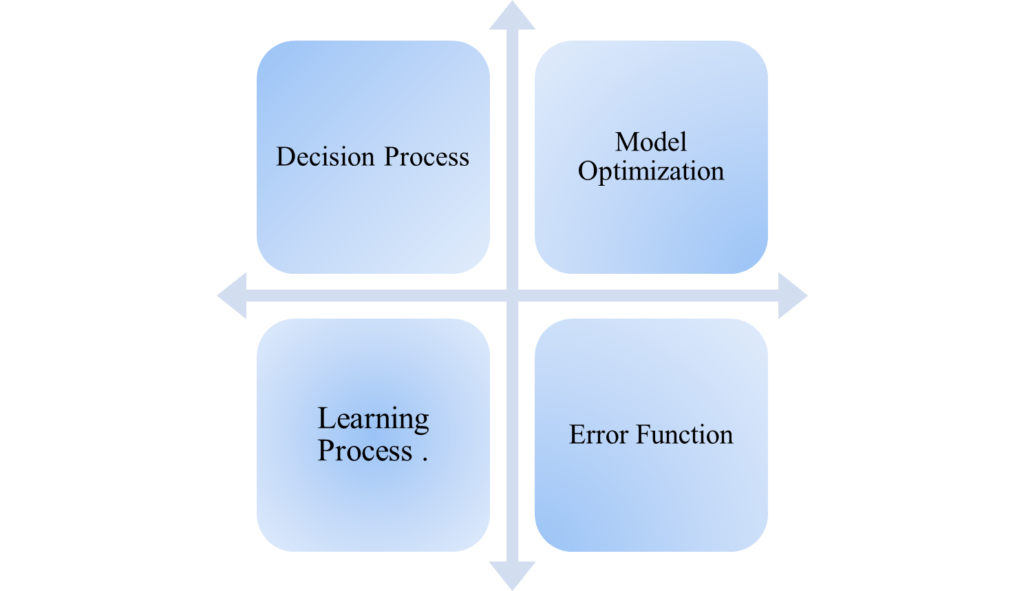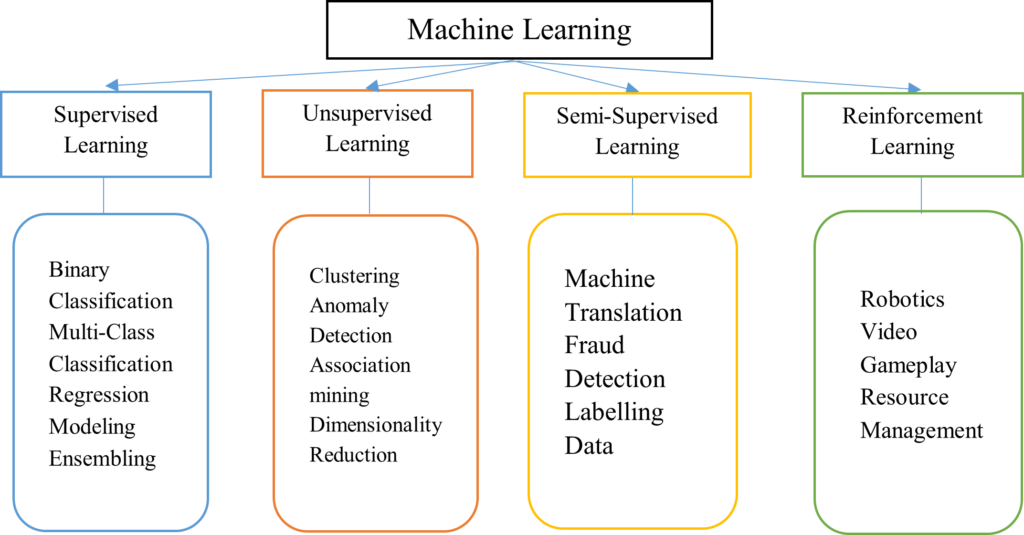By: A. Khan, K. T. Chui, D. Peraković
Future scope of Machine Learning (ML) and AI is high, as it provides the machine a capability to acquire knowledge, which makes it a more human-like machine. Machine learning is currently in use, maybe in so many domains as one might imagine. Overall, this article will provide a basic overview of the timeline, types of machine learning, and present industrial applications of this technology.
Scope of Machine learning and Artificial Intelligence
Machine learning is a sub-category of artificial intelligence (AI) that enables software programs to improve their prediction accuracy without even being expressly designed to do so. In order to forecast accurate outcomes, machine learning algorithms leverage old datasets. Spam filtering, fraud detection, smart healthcare system, speech recognition, computer vision, and smart transportation are some of the popular usages of machine learning technology [1]. Talking about the evolution of machine learning, the term “Machine Learning” was first coined by “Arthur Lee Samuel” in 1959. He was an American trailblazer in the field of “Computer Gaming and Artificial Intelligence” [2]. The “Samuel Checkers-Playing Program” was one of the world’s earliest practical self-trained algorithms, and became a former example of artificial intelligence’s foundational theory. Figure 1 depicts the timeline and evolution of machine learning technology.

Machine Learning plays a vital role in the field of enterprises as it enables entrepreneurs to pretend the customers’ behavior and business functioning behavior. Nowadays leading companies like Google, Amazon, MAC, Uber, and many more are utilizing these technologies in an efficient way, as a result, machine learning become a core operational part of functioning [3-5].
How does Machine Learning Work?
University of California, Berkeley categorized the learning process of machine learning algorithm into three main parts; Decision Process, Error Function, and Model Optimization Process [4] as shown in Fig. 2.

In Decision making process, predictions rely on the input data. When some raw dataset is given to the algorithm, it will generate some kind of prediction that will define a pattern inside input data.
An Error Function depicts the percentage of failing to achieve the desired output.
In Model Optimization process, weights are modified to minimize the difference between estimated output and actual output. The model will update the weights until the desired threshold value is achieved.
What is the Classification of Machine learning?
Basically, Machine Learning is categorized into four different parts named as Supervised Learning, Unsupervised Learning, Semi-Supervised Learning, and Reinforcement Learning [5]. Figure 3 illustrates the good working aspects of these learning techniques.

- Supervised Learning: In supervised learning, algorithms are trained with labeled datasets. In addition to this, input and output to the algorithm are already specified. Some examples of supervised learning are, support vector machine (SVM), linear regression, naïve bayes etc.
- Unsupervised Learning: In unsupervised Learning, algorithms are trained with unlabeled datasets. Algorithm go through whole data to make some meaningful predictions. Some popular examples of unsupervised learning are, K-means algorithm, probabilistic clustering etc.
- Semi-Supervised Learning: In semi supervised learning, it contains the combination of both supervised and unsupervised learning. Model is trained with labeled datasets but in this case, algorithm is flexible to choose their own decisions and predictions will be based on its own understandings.
- Reinforcement Learning: It is similar to the supervised learning but the fundamental difference between both of them is that, in reinforcement learning training of data is not done with labeled datasets rather than this model trained itself with trails and errors. To establish the optimal solution or strategy for a specific situation, a series of successful results will be reinforced.
Machine Learning Applications
In this part, we will discuss some of the examples of state-of-the-art applications [6, 7]:
- Speech Recognition: It can be defined as the capability of machines to recognize the words spoken by humans and transform into legible text. It is also identified as “Automatic Speech Recognition (ASR)” or “Speech to Text”
- Customer Services: In present scenario, human agents are replaced with the online chatbots. Customers just ask their queries online like product specifications, sale/purchase, shipping etc, and they get their solutions online (Frequently Asked Questions) or by means of emails. Various virtual and voice assistance are also provided by renowned companies.
- Computer Vision: It is an integral part of Artificial Intelligence technology. This technology retrieves significant information from real-time environment for example, digital images/ videos and depending on the input data it reacts accordingly. Computer vision technology is a burning matter nowadays, it is implemented in numerous domains like, self- driving cars, healthcare and social media.
- Stock Trading: Machine learning is implemented in the stock exchange industry as well. Millions and billions of trades is now dependent on this technology without human interventions.
- Healthcare Sector: ML plays a crucial role in medical-care sector, as in present scenario it is possible to track and diagnose any chronic diseases with the help of ML and AI. In Covid-19 pandemic these technologies are very useful for detection of victim patients. Online remedy facilities are gotten possible with the integration of ML techniques.
Future Scope of Machine Learning
There is no doubt that expansion of the machine learning across every domain is a burning matter nowadays. Industries like automotive, entertainment, gaming, finance, and healthcare are revolutionized with the integration of machine learning techniques. The emerging scope of ML will enhance the performance of machines with less intervention of human beings. The main motive of the integration of machine learning into various domains is to reduce error function and improve the real time results at minimum cost and time. Below are some of the future scope of the machine learning technology that will provide great impact in upcoming years;
- Robotics: In upcoming years, this technology will boom the robotics domain. As a lot of research is going on in this field for example, Japan created its robot “Erica” that becomes the first robot news anchor. In Dubai, they created “Sophia” and it becomes first robot that is carrying Saudi Arabian Citizenship. With the advancement in AI and ML, robots mimic the human gestures and perform tasks with high accuracy.
- Computer Vision: As the name suggested “Computer Vision” it works same as it is known for. It provides vision to the machine or computer. This technique empowers the machines to recognize and analyze digital images, videos and graphics. On the bases of the reorganization and analyzing it will deliver the output with minimum error.
- Quantum Computing: The discipline of machine learning has the potential to be transformed and innovated by quantum algorithms. It could digest data at a far quicker rate, allowing it to make conclusions and consolidate knowledge more quickly.
- Automotive Industry: with the help of ML, the concept of “Safe Driving” came into picture. In the present scenario renowned firms like Google, Tesla, Mercedes Benz has already invested a huge amount of efforts in designing “Auto Pilot” concept. By means of wireless sensors, Internet of Things, HD cameras and audio/ video recognition system it is possible to implement this concept properly.
- Cyber Security: Nowadays, banks and financial institutes implement machine learning to halt malpractices. Phishing is one of the major concern these days, to rectify phishing emails various classification and regression techniques are imposed to prevent customers from online frauds.
References
[1] Goodfellow, I., Bengio, Y., & Courville, A. (2016). Machine learning basics. Deep learning, 1(7), 98-164.
[2] Jordan, M. I., & Mitchell, T. M. (2015). Machine learning: Trends, perspectives, and prospects. Science, 349(6245), 255-260.
[3] Yao, Q., Wang, M., Chen, Y., Dai, W., Li, Y. F., Tu, W. W., … & Yu, Y. (2018). Taking human out of learning applications: A survey on automated machine learning. arXiv preprint arXiv:1810.13306.
[4] K. Yadav, M. Quamara, B. Gupta, 2021 Hot Topics in Machine Learning Research. Insights2Techinfo, PP. 1. Available at: https://insights2techinfo.com/2021-hot-topics-in-machine-learning-research/
[5] A. Dahiya (2021), Blockchain and Artificial Intelligence for Industrial Automation, Insights2Techinfo, pp. 1. Available at: https://insights2techinfo.com/blockchain-and-artificial-intelligence-for-industrial-automation/
[6]Jiang, T., Gradus, J. L., & Rosellini, A. J. (2020). Supervised machine learning: a brief primer. Behavior Therapy, 51(5), 675-687.
[7] Singh, A., Thakur, N., & Sharma, A. (2016, March). A review of supervised machine learning algorithms. In 2016 3rd International Conference on Computing for Sustainable Global Development (INDIACom) (pp. 1310-1315). Ieee.
[8] Usama, M., Qadir, J., Raza, A., Arif, H., Yau, K. L. A., Elkhatib, Y., … & Al-Fuqaha, A. (2019). Unsupervised machine learning for networking: Techniques, applications and research challenges. IEEE access, 7, 65579-65615.
[9]Libbrecht, M. W., & Noble, W. S. (2015). Machine learning applications in genetics and genomics. Nature Reviews Genetics, 16(6), 321-332.
Cite this article:
A. Khan, K. T. Chui, D. Peraković (2021) Future Scope of AI and Machine Learning in 2022, Insights2Techinfo, pp.1
FAQ on Machine Learning
Healthcare, robotics, quantum computing, cyber security, are some of the scopes of machine learning
Error reducing technique in machine learning is called regularization.
These are the machine learning simulation tool
It is a machine learning algorithm mainly used with labeled datasets.
It is a machine learning algorithm.
One training transit of machine learning or deep learning is called an epoch